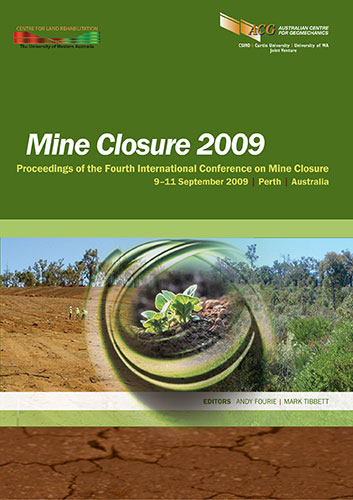Reliability of using laboratory-determined soil water characteristic data for mine waste cover design

|
Authors: Williams, DJ; Rohde, TK |
DOI https://doi.org/10.36487/ACG_repo/908_38
Cite As:
Williams, DJ & Rohde, TK 2009, 'Reliability of using laboratory-determined soil water characteristic data for mine waste cover design', in AB Fourie & M Tibbett (eds), Mine Closure 2009: Proceedings of the Fourth International Conference on Mine Closure, Australian Centre for Geomechanics, Perth, pp. 493-504, https://doi.org/10.36487/ACG_repo/908_38
Abstract:
Soil water characteristic curves (SWCCs) used for the design of covers over mine wastes, are typically determined in the laboratory by performing drying tests on samples in a Tempe cell. In some cases, re- wetting is also carried out. The advantage of using drying tests is that they are carried out from the saturated state at a given sample test density, so that there is some chance of obtaining repeatable results. However, re-wetting is carried out from the arbitrary end-point of a drying test, giving a different re-wetting curve from each of these points. SWCC data may also be measured directly in the laboratory and in the field. Depending on the uniformity, stress history, structure and any cementation of soils under laboratory or field conditions, their SWCC data may be very different from the SWCC data collected after sample preparation and saturation for laboratory Tempe cell drying testing. The paper presents in situ, laboratory and field SWCC data for mine waste covers that highlight the strong influence that structure, cementation, sampling disturbance, sample preparation, saturation, uniformity, construction control and stress history can have on the data. They cast some doubt on the design of mine waste covers based solely on the use of laboratory- determined SWCCs.
References:
INAP (International Network for Acid Prevention) (2003) Evaluation of the long-term performance of dry cover
Rohde, T.K. (2009) Development of innovative landform and closure designs for potentially contaminating surface
waste rock dumps, University of Queensland, Australia, PhD thesis, (unpublished).
Shurniak, R.E. (2003) Predictive modeling of moisture movement within soil cover systems for saline/sodic overburden
piles, Department of Civil Engineering, University of Saskatchewan, Canada, MSc thesis, (unpublished).
Williams, D.J., Wilson, G.W. and Currey, N.A. (1997) A cover system for a potentially acid forming waste rock dump
in a dry climate. Proceedings of Fourth International Conference on Tailings and Mine Waste, Waste ’97, Fort
Collins, Colorado, USA, 13–17 January 1997, A.A. Balkema, Rotterdam, pp. 231–235.
Williams, D.J., Rohde, T.K., Stolberg, D.J. and Pope, G. (2006a) Alternative design and instrumentation of covers over
potentially acid forming mine wastes. Proceedings of Fifth International Congress on Environmental
Geotechnics, Cardiff, Wales, 26–30 June 2006, Thomas Telford, pp. 1007–1014.
Williams, D.J., Stolberg, D.J. and Currey, N.A. (2006b) Long-term performance of a “store/release” cover over
potentially acid forming waste rock in a semi-arid climate, Proceedings of Fourth International Conference on
Unsaturated Soils, Carefree, Arizona, 2–6 April 2006, ASCE, Geo Institute, pp. 756–776.
© Copyright 2026, Australian Centre for Geomechanics (ACG), The University of Western Australia. All rights reserved.
View copyright/legal information
Please direct any queries or error reports to repository-acg@uwa.edu.au
View copyright/legal information
Please direct any queries or error reports to repository-acg@uwa.edu.au